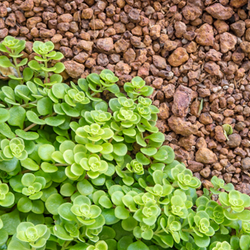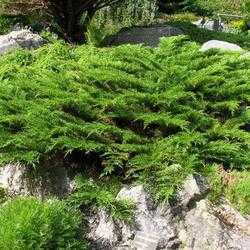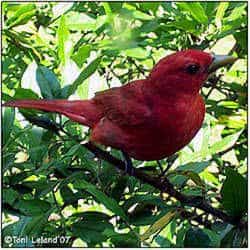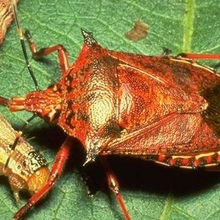(Editor's Note: This article was originally published on February 13, 2008. Your comments are welcome, but please be aware that authors of previously published articles may not be able to promptly respond to new questions or comments.)
Common Juniper, Juniperus communis
In addition to J. communis, other edible species include J. drupacea (Syrian juniper), J. oxycedrus (prickly juniper), J. phoenicea (Phoenicean juniper), J. deppeana (wild juniper or alligator juniper which drops its waxy berries), J. virginiana (Eastern red cedar or red cedar juniper) and J. californica (California juniper). [1]
 Some species' berries shoulod not be eaten, so identification is important. The berries of Juniperus monosperma (one-seed juniper) are rather unpalatable. This tree-like, bluish juniper is used in landscaping and looks a little like an arborvitae. The berries of J. sabina (Savin juniper), are toxic and consumption is inadvisable. [2] If the shrub is a needle-leafed evergreen with red berries, it is a yew, and its berries and could cause a gruesome death.
Some species' berries shoulod not be eaten, so identification is important. The berries of Juniperus monosperma (one-seed juniper) are rather unpalatable. This tree-like, bluish juniper is used in landscaping and looks a little like an arborvitae. The berries of J. sabina (Savin juniper), are toxic and consumption is inadvisable. [2] If the shrub is a needle-leafed evergreen with red berries, it is a yew, and its berries and could cause a gruesome death.
The berries are greenish the first year and bluish purple when ripe the second year. They taste best late in the second year and are sweeter yet in the spring of the third year when they are sweeter. Some people enjoy eating them raw, while others find them distasteful.
Culinary Uses
I first heard of using juniper berries when a friend gave me some venison and I decided to make venison sausage. The tastiest sounding recipe called for juniper berries to cut the "gamey" taste. Since then I have discovered a whole list of recipes using the berries.
Their primary food use of juniper berries is as a seasoning and can be used to flavor stew or meat. Some Indians dried them for winter use, grinding into a mush and forming them into cakes. The berries have been roasted and ground for use as a coffee substitute. Also, Juniper leaves can be used to add a smoky flavor to grilled fish.
Juniper berries perform a quite unique role by contributing as much to the character of food not only by way of their specific taste profile but also through their 'freshening' ability. As well as flavoring a dish, juniper cuts the gaminess of game, reduces the fatty effect of duck and pork and perks up a bread stuffing. [3]
Dried Juniper Berries
 The hearty flavor of juniper goes well with the strong flavors of red mkeat and game. Pork chops, roast leg of lamb, veal, rabbit, venison and wild boar are all enlivened with a hint of juniper. Six juniper berries per pound of meat is excellent with moose, venison or rabbit and poultry. Juniper berries blend well with other herbs and spices, especially thyme, sage, oregano, marjoram, bay leaves, allspice, onions and garlic.[4]
The hearty flavor of juniper goes well with the strong flavors of red mkeat and game. Pork chops, roast leg of lamb, veal, rabbit, venison and wild boar are all enlivened with a hint of juniper. Six juniper berries per pound of meat is excellent with moose, venison or rabbit and poultry. Juniper berries blend well with other herbs and spices, especially thyme, sage, oregano, marjoram, bay leaves, allspice, onions and garlic.[4]
In Sweden, juniper berries season pâtés and sauces. Goulash and Sauerkraut often feature a juniper taste, as do some home-pickled meats like salt beef, salt pork and ham. Generally juniper is a good addition to any dish requiring alcohol. Fruit dishes, such as apple tarts and pickled peaches, also harmonize with this flavor.[5]
In the 1500s, a Dutch pharmacist created a "new" inexpensive diuretic using the juniper berry. He called the new product gin. The drink caught on (for other reasons) and today the juniper berry is still giving gin its distinctive and well-known flavor.[6]
Medicinal Uses
The berries were used by herbalists in the Middle Ages to prevent infection and avoid contagious diseases. Those who treated people during the Black Death usually kept a few berries in their mouths forming an antiseptic barrier. A strong tea of the berries was used as a disinfectant for needles and bandages.[6]
The Cree called juniper Ka-Ka-Kau-mini and made a poultice for wounds out of the inner bark. J. horizontalis is called sik-si-nou-koo (black round objects) by the Blackfoot. Many Indian tribes believed that if a woman took a daily tea made with five juniper berries, she would not become pregnant.
A liniment was made by the Blackfoot to remedy backaches by infusing juniper root and poplar leaves. They also used an infusion of the root as a general tonic. People drank juniper berry tea for sore throats, colds and tuberculosis. The Inipiat used a berries and twigs tea for respiratory problems. An “incense” of the needles has often been burned to cleanse a house, driving infectious disease out.[6]Juniper oil extract has been used as an external application for stiff joints, but should be diluted with other oils (e.g. olive or almond oil) because it can cause blisters.[7]
Juniper is well known by today's herbalists as an excellent diuretic, cleansing out the kidneys and bladder. It is especially effective for dissolving kidney stones. The oil of juniper can be irritating to the kidneys if they are weak. To avoid this, juniper is usually used with a demulcent such as marshmallow root. Juniper berries may be used to treat digestive problems. The berries are known to stimulate the production of hydrochloric acid in the stomach. Juniper berries have also been used to expel gas.[7]
 Other Uses
Other Uses
Juniper berries and roots can be used to make brown and purple dyes. The Blackfoot used juniper branches to floor their sweat lodges and to floor the Sun Dance lodge. Some proud Native American horse owners would bathe their horses in water in which juniper root had been soaked. This would make the horsehair shine. A decoction of juniper branches is an anti-dandruff rinse.
Black beads can be made from juniper berries by this traditional method. After collecting a fair quantity of berries, you string them on a small sliver of wood and let them dry. After they have dried, pour grease on the fire and smoke the dried berries in the thick smoke, turning the berries black. Polish and string the beads interspersing with wolf willow beads.
For a plant versatile enough to offer edible parts, to provide craft materials and to be pleasing to the eye, try junipers in YOUR garden!
Thanks to Xenomprf, Evert, Kennedyh and palmbob for use of their photos in Plantfiles!
Footnotes:
[1] http://www.wrc.net/wrcnet_content/herbalresources/herbwalk/herbwalk.aspx?hwid=30
[2]Grieve, M. (1984). A Modern Herbal. Penguin. ISBN 0-14-046440-9
[3], [4], [5] http://www.theepicentre.com/Spices/juniper.html
[6] ] http://www.emedicinal.com/herbs/juniperberry.php
[7] http://www.wrc.net/wrcnet_content/herbalresources/herbwalk/herbwalk.aspx?hwid=30
















